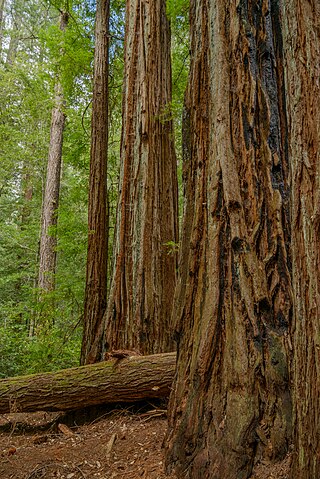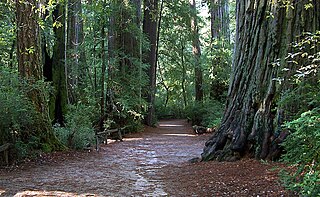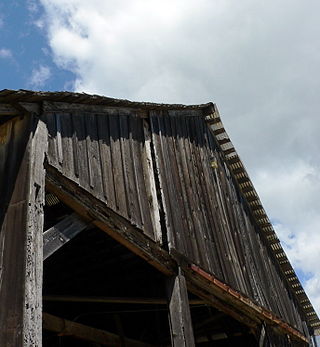
Gilroy is a city in Santa Clara County, California, United States. Gilroy is a city south of the San Francisco Bay Area, with a population of 59,520 as of the 2020 Census.

The Santa Cruz Mountains are a mountain range in central and Northern California, United States, constituting a part of the Pacific Coast Ranges. They form a ridge down the San Francisco Peninsula, south of San Francisco. They separate the Pacific Ocean from the San Francisco Bay and the Santa Clara Valley, and continue south to the Central Coast, bordering Monterey Bay and ending at the Salinas Valley. The range passes through the counties of San Mateo, Santa Clara, and Santa Cruz, with the Pajaro River forming the southern boundary.

Silicon Valley Monterey Bay Council (#055) is a Boy Scouts of America council headquartered in San Jose, California. It was the result of a council merger between the Santa Clara County Council and the Monterey Bay Area Council. In 2004, the previous two councils served over 11,000 youth in over 400 Boy Scout troops, Cub Scout packs, Venturing crews, and Explorer posts. In 2012, the Monterey Bay Area Council announced that after 89 years as a separate council, it had agreed to merge back into the Santa Clara County Council. As of 2013, the council served 13,000 youth in four different counties.

Big Basin Redwoods State Park is a state park in the U.S. state of California, located in Santa Cruz County, about 36 km (22 mi) northwest of Santa Cruz. The park contains almost all of the Waddell Creek watershed, which was formed by the seismic uplift of its rim, and the erosion of its center by the many streams in its bowl-shaped depression.

Monterey State Historic Park is a historic state park in Monterey, California. It includes part or all of the Monterey Old Town Historic District, a historic district that includes 17 contributing buildings and was declared a National Historic Landmark in 1970. The grounds include California's first theatre, and the Monterey Custom House, where the American flag was first raised over California.

Sempervirens Fund, originally established in 1900 as Sempervirens Club, is California's oldest land trust. Founder Andrew P. Hill’s goal was to preserve the old-growth forest that became Big Basin Redwoods State Park, the first California state park in 1902. Sempervirens Fund's mission is to protect and permanently preserve coast redwood forests, wildlife habitat, watersheds, and other important natural features of California's Santa Cruz Mountains, and to encourage people to appreciate and enjoy this environment. Sempervirens Fund does this by purchasing land for protection and transferring it to state or local agencies. Sempervirens Fund has also worked to establish conservation easements and trail linkages between parks and coastal marine preserves. As of 2013, Sempervirens Fund has saved more than 34,000 acres of redwood lands.

Gilroy Yamato Hot Springs, a California Historical Landmark and on the list of National Register of Historic Places, is a property near Gilroy, California famed for its mineral hot springs and historic development by early settlers and Japanese immigrants. The earliest extant Italianate–Victorian style structures date from the 1870s, and the earliest bathhouse dates from 1890. Other early structures are a Buddhist shrine from 1939 and a Japanese garden teahouse from that same year. The property is also listed on the National Register of Historic Places. The hot spring's temperature ranges from 99° to 111 °F. These springs are the site of occurrence of certain extremophile micro-organisms, that are capable of surviving in extremely hot environments.
Chemeketa Park is an unincorporated community of approximately 150 homes located in Lexington Hills, in the Santa Cruz Mountains in Santa Clara County, California, that is now effectively a rural neighborhood of Los Gatos, California. The postal designation for Chemeketa Park is "Los Gatos 95033", although it lies approximately five miles South of the official boundaries of the incorporated town of Los Gatos. The community is in area codes 408 and 669.

Sanborn County Park is a 3,453 acre (13.97 km2) county park situated in the Santa Cruz Mountains, managed by the Santa Clara County Parks and Recreation Department. The deeply forested park features over 15 miles of trails, second-growth redwoods, and creeks that flow year-round. It offers hiking, RV camping, walk-in campsites, and picnicking/BBQ sites. In the summer months, Sanborn County Park hosts the only outdoor Shakespearean company in Silicon Valley.

The Joaquin Miller House, also known as The Abbey, is a historic house in Joaquin Miller Park, a public park in the Oakland Hills area of Oakland, California, United States. A crude, vaguely Gothic structure, it was the home of poet Joaquin Miller from 1886 until his death in 1913. Miller was one of the nation's first poets to write about the far western United States. The property, which includes several idiosyncratic monuments created by Miller, was designated a National Historic Landmark in 1962.

The Cowell Lime Works, in Santa Cruz, California, was a manufacturing complex that quarried limestone, produced lime and other limestone products, and manufactured wood barrels for transporting the finished lime. Part of its area is preserved as the Cowell Lime Works Historic District, which was listed on the National Register of Historic Places in 2007. In addition to the four lime kilns, cooperage and other features relating to lime manufacture, the Historic District also includes other structures associated with the Cowell Ranch, including barns, a blacksmith shop, ranch house, cook house and workers' cabins. The 32-acre Historic District is located within the University of California, Santa Cruz campus, to either side of the main campus entrance.

Alma is a ghost town and drowned town in Santa Clara County in California, United States. It lies beneath the waters of the Lexington Reservoir above Los Gatos. The location is latitude 37.18N and longitude 121.98W. It was 551 feet above sea level.

This is intended to be a complete list of the properties and districts on the National Register of Historic Places in Santa Clara County, California, United States. Latitude and longitude coordinates are provided for many National Register properties and districts; these locations may be seen together in an online map.

Santa Clara County, officially the County of Santa Clara, is the sixth-most populous county in the U.S. state of California, with a population of 1,936,259 as of the 2020 census. Santa Clara County and neighboring San Benito County form the San Jose–Sunnyvale–Santa Clara metropolitan statistical area, which is part of the larger San Jose–San Francisco–Oakland combined statistical area. Santa Clara is the most populous county in the San Francisco Bay Area and in Northern California.

The California Powder Works Bridge is a historic covered bridge in Santa Cruz, California. It is a Smith truss bridge, built across the San Lorenzo River in 1872 by the California Powder Works, an explosives manufacturer whose factory complex stood on the river banks. The bridge was designated a National Historic Landmark in 2015 as one of the best-preserved national examples of the Smith truss. It is owned and maintained by the Paradise Park Masonic Club, and is open to pedestrian and vehicular traffic, with a posted weight limit of 5 tons.

The Headquarters Administration Building of Big Basin Redwoods State Park, Santa Cruz County, California, was a historic structure built in 1936 by crews of the Civilian Conservation Corps. It was built out of local materials, and was one of the best-preserved examples of the CCC's work in the California state park system. The building continued to perform its original function, housing the park's administrative offices and serving as a contact point for park visitors, until it was destroyed by the wildfires sparked by the lightning storm of August 16, 2020. It was listed on the National Register of Historic Places in 2017, and was delisted in 2023.

The Old City Hall is a historical building built in 1905, and once served as a courthouse, the mayor's office, a jail, a clerk office, and fire department. The building is located at 7410 Monterey Street in Gilroy, California. It is listed on the National Register of Historic Places listings in Santa Clara County, California since April 16, 1975. The building is a good example of Californian architecture and the Mission Revival style at the turn of the century. It was nicknamed the "Grand Old Lady".

The Stevenson House, is a historic two-story Spanish Colonial style building located at 530 Houston Street in Monterey, California. It was a boarding house called the French Hotel, built circa 1836. The Scottish author Robert Louis Stevenson lived there in 1879, writing and courting his future wife. It is now a museum and property of the Monterey State Historic Park. The building was listed on the National Register of Historic Places on January 7, 1972. The building is also listed as a California historical landmark #352.

The Miller Red Barn is a historic wooden hay barn constructed in 1891, in Gilroy, California, using pole construction techniques. It was erected on land belonging to Henry Miller, a prominent California cattle baron of that era. The barn is most known for its connection to agriculture production in Santa Clara County, and its role within the agricultural estate of Henry Miller, who was a partner in the cattle-raising and meat-packing enterprise of Miller & Lux in San Francisco. The Miller Red Barn was placed on the National Register of Historic Places on September 26, 2016.

Welch-Hurst, also known as the Judge J.R. Welch's Ranch, is a historic gentleman's working ranch and family retreat in Saratoga, California. This ranch represents an early example of American Craftsman-style architectural, built for Judge James R. Welch. The Welch-Hurst ranch was placed on the National Register of Historic Places on September 18, 1978.





















